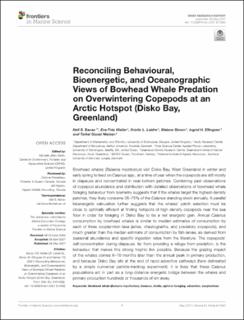| dc.contributor.author | Banas, Neil S. | |
| dc.contributor.author | Møller, Eva Friis | |
| dc.contributor.author | Laidre, Kristin L. | |
| dc.contributor.author | Simon, Malene | |
| dc.contributor.author | Ellingsen, Ingrid H. | |
| dc.contributor.author | Nielsen, Torkel Gissel | |
| dc.date.accessioned | 2022-10-19T07:25:55Z | |
| dc.date.available | 2022-10-19T07:25:55Z | |
| dc.date.created | 2021-08-03T09:47:29Z | |
| dc.date.issued | 2021 | |
| dc.identifier.citation | Frontiers in Marine Science. 2021, 8 . | en_US |
| dc.identifier.issn | 2296-7745 | |
| dc.identifier.uri | https://hdl.handle.net/11250/3026899 | |
| dc.description.abstract | Bowhead whales (Balaena mysticetus) visit Disko Bay, West Greenland in winter and early spring to feed on Calanus spp., at a time of year when the copepods are still mostly in diapause and concentrated in near-bottom patches. Combining past observations of copepod abundance and distribution with detailed observations of bowhead whale foraging behaviour from telemetry suggests that if the whales target the highest-density patches, they likely consume 26–75% of the Calanus standing stock annually. A parallel bioenergetic calculation further suggests that the whales' patch selection must be close to optimally efficient at finding hotspots of high density copepods near the sea floor in order for foraging in Disko Bay to be a net energetic gain. Annual Calanus consumption by bowhead whales is similar to median estimates of consumption by each of three zooplankton taxa (jellies, chaetognaths, and predatory copepods), and much greater than the median estimate of consumption by fish larvae, as derived from seasonal abundance and specific ingestion rates from the literature. The copepods' self-concentration during diapause, far from providing a refuge from predation, is the behaviour that makes this strong trophic link possible. Because the grazing impact of the whales comes 6–10 months later than the annual peak in primary production, and because Disko Bay sits at the end of rapid advective pathways (here delineated by a simple numerical particle-tracking experiment), it is likely that these Calanus populations act in part as a long-distance energetic bridge between the whales and primary production hundreds or thousands of km away. | en_US |
| dc.language.iso | eng | en_US |
| dc.publisher | Frontiers | en_US |
| dc.rights | Navngivelse 4.0 Internasjonal | * |
| dc.rights.uri | http://creativecommons.org/licenses/by/4.0/deed.no | * |
| dc.subject | zooplankton | en_US |
| dc.subject | advection | en_US |
| dc.subject | optimal foraging | en_US |
| dc.subject | Arctic | en_US |
| dc.subject | Calanus | en_US |
| dc.subject | Bowhead whale (Balaena mysticetus) | en_US |
| dc.title | Reconciling Behavioural, Bioenergetic, and Oceanographic Views of Bowhead Whale Predation on Overwintering Copepods at an Arctic Hotspot (Disko Bay, Greenland) | en_US |
| dc.type | Peer reviewed | en_US |
| dc.type | Journal article | en_US |
| dc.description.version | publishedVersion | en_US |
| dc.rights.holder | Copyright © 2021 Banas, Møller, Laidre, Simon, Ellingsen and Nielsen. This is an open-access article distributed under the terms of the Creative Commons Attribution License (CC BY). The use, distribution or reproduction in other forums is permitted, provided the original author(s) and the copyright owner(s) are credited and that the original publication in this journal is cited, in accordance with accepted academic practice. No use, distribution or reproduction is permitted which does not comply with these terms. | en_US |
| dc.source.pagenumber | 9 | en_US |
| dc.source.volume | 8 | en_US |
| dc.source.journal | Frontiers in Marine Science | en_US |
| dc.identifier.doi | 10.3389/fmars.2021.614582 | |
| dc.identifier.cristin | 1923549 | |
| dc.source.articlenumber | 614582 | en_US |
| cristin.ispublished | true | |
| cristin.fulltext | original | |
| cristin.qualitycode | 1 | |

